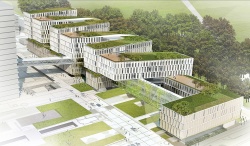Architecture soothes the sick
Might spatial atmosphere play a key role in patient recoveries – or are the expertise of doctors and nurses and exquisite medical equipment the only important issues in healing?
Report: Bettina Döbereiner

Architecture plays a vital role in healing, according to the majority of participants in the session Healing, Architecture and Communication, held in Berlin this March during the one-day 5th Symposium for Future Healthcare.
In just a day, architects, physicians, other healthcare providers and scientists managed to present and discuss their latest findings on healthcare-related buildings and interiors as well as plans for the future.
Thirty years ago a study from architect Roger Ulrich had already scientifically suggested that the layout of a building has an impact on medical outcomes for patients. The ‘View from a window may influence recovery from surgery’ study indicated that surgical patients overlooking a natural scene received fewer negative evaluative comments in nurses’ notes, took fewer potent analgesics and had shorter postoperative hospital stays than those who looked out onto a brick wall. Since this relatively small size (46 patients), nevertheless a path-breaking study that was published in Science magazine in 1984, more scientific research has been done and is being carried out in this field, by now known as Evidence-based Design (EbD).
Nowadays, Roger Ulrich’s early insights appear to be implemented in hospital planning. At least the presentations at the symposium lead one to conclude that. For example, architect Bo Boje Larsen, from Denmark, showed his and his office‘s draft for the extension of Copenhagen’s main hospital, the Rigshospitalet, funded by the capital Region of Denmark. When designing, he said, the main issue was to offer staff and patients as much natural daylight and as many greenery perspectives as possible – within and outside the new building. Thus, to allow for as many windows as possible, the planned structure has a kind of zigzag-footprint.
One of the most outstanding and ambitious EbD research-projects - progressing far beyond Ulrich’s early findings – was presented by architect Thomas Willemeit, who spoke on the total modernisation of two ICU rooms at the Charité University Hospital in Berlin. In October last year the so-called Parametric Room Concept, a pilot project of Charité, Graft architect‘s office, Mediadesigner Art+Com and other partners, was inaugurated at the ward 8i of the Charité Campus Virchow-Clinic.
Background: Charité anaesthetist and project leader Professor Claudia Spies, and colleagues found in their various studies that cognitive dysfunction and delirium in ICUs also appear to be induced by stress factors, such as noise, but also the usual lack of daylight in ICUs, the unnatural and permanent presence of artificial lights, the resultant chaos in melatonin-oppression inter alia provoking an irregular sleep/wake rhythm, the frightening and impersonal surroundings, jungle of cables and so forth. Hence a multidisciplinary team developed a concept for an ICU that should particularly reduce patient stress.
What had been done to realise this aim? The loudness of alarms was reduced and avoided if possible; technical devices are hidden behind a wooden wall, with noise re-absorbing materials used, e.g. wood; each patient has a small, intimate space, or notch, in the form of an elevated storage shelf at the bedside. In addition, the ceiling above the patient’s bed is a big screen, to provide different kinds of light to imitate natural changes, hence supporting the natural melatonin-suppression and consequently promoting a better wake/sleep rhythm. There are also many additional tools. The effects of this forward-looking design are now being studied in a research project co-funded by the German Federal Ministry for Economic Affairs and Energy.
Former cancer nurse Laura Lee presented not a scientific, EbD-driven approach, but a personal one to enhance patients’ health and well being through architecture. Recounting the story of the formation of the first of Britain’s Maggie‘s Centres in Edinburgh, Scotland, in 1996, she spoke of her late patient Maggie Keswick Jencks, who had personally experienced how frightening, disorientating and isolating a cancer diagnosis can be.
In 1993, 47-year-old Maggie was given the news that she had just 2-3 months to live. A designer and passionate gardener, with husband Charles, a writer and landscape architect, she found herself absorbing the awesome verdict under neon lights in a dreary corridor and they quickly realised something had to be done to help cancer patients to cope better with their diagnoses. The couple developed ideas for cancer care and, with input from Maggie’s then nurse Laura Lee, as well as others, a concept for a special centre was born on the grounds of the National Health Service (NHS) cancer hospital where Maggie was treated. Unfortunately, she died before the opening of the centre.
Since that time, 17 Maggie‘s Centres have opened at major NHS cancer hospitals in the UK, and abroad, to provide free practical, emotional and social support to cancer patients, their families and friends. One of the unique features of the centres is that world famous architects, including their friends Zaha Hadid and Frank Gehry, have given each an extra-special design.
Laura Lee, who became CEO of Maggie’s Centres, explained the organisation’s aims: ‘The essence of our brief for architects, landscape-planners and interior designers is to build a home for people with these feelings: loss of control, hopelessness and helplessness and feelings of isolation. We believe that kindling curiosity and imagination is fundamental to feeling alive, people sense: Hey, you are in this building, you are alive, life’s worth living today,’ she added. The positive feedback from patients and relatives, as well as physicians, proved the concept of the charity-driven Maggie‘s Centres was sound.
As two other lectures at the symposium demonstrated, Maggie‘s has been the model for at least two designs: the Copenhagen Centre for Cancer (completed in 2012) and plans for a new facility for the Prince & Princess of Wales Hospice in Glasgow.
The success story of Maggie‘s Centres illustrates that EbD doesn’t have to be a precondition to point the way forward. Initiatives based on personal experience and the courage to play out/realise one’s visions can also pave the way to future healthcare.
* The Symposium for Future Healthcare was organised by the department of hospital and healthcare building design, located at the faculty of architecture faculty at Berlin’s Technical University (TU).
10.11.2014





